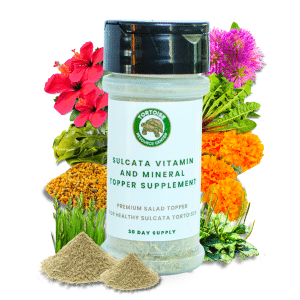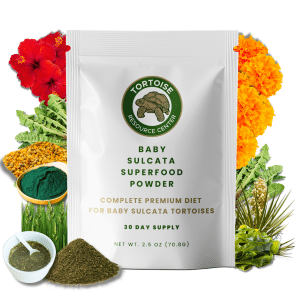Stomatitis, commonly known as ‘mouth rot’, is a common condition caused when pathogens such as bacteria, fungi or viruses get into an open sore in the mouth and cause infection in the oral tissues. This unpleasant condition is most common in reptiles, most notably affecting tortoises, turtles, snakes, and lizards.
Mouth rot can seriously impact a tortoise’s health and well-being. The ramifications range from general weakness to respiratory issues and even death. Although pathogens are responsible for causing mouth rot, the real culprit is inadequate husbandry which allows the infection to take hold.
In this article I’ll be discussing how to spot mouth rot, the measures you can take to treat and prevent it, and when you should seek veterinary help. Although it sounds scary, mouth rot can be treated and with proper care and husbandry, you can ensure the health, happiness and longevity of your beloved pet.
Recognizing the Signs of Mouth Rot
Generally, the first sign of tortoise mouth rot is lack of appetite. A tortoise suffering from this disease will show a decreased interest in food or completely stop eating altogether.
This is because mouth rot causes pain and discomfort in the mouth, which makes eating both difficult and unappealing. This can lead to weight loss and general lethargy.
Take note however, as a sudden lack of appetite can also be a sign of a respiratory infection, and should therefore be taken seriously. Look out for leftover food in the enclosure, as well as signs of your tortoise approaching its food but not consuming it.
The physical signs of mouth rot are wide and varied. Some are easier to spot than others and in the majority of instances, will become more detrimental to the health of your tortoise if left untreated.
As a conscientious owner, it’s important to take note of and monitor any changes in behavior and/or physical characteristics. This can be done by conducting a thorough inspection of your tortoise at least every week and getting them checked out by a veterinarian every 6 months to help identify any of the following signs:
1. Discharge
A key symptom of mouth rot is thick, visible pus or discharge around the mouth or nose.
This discharge is a sign of bacterial infection and is often described as ‘cheesy-looking’ and can be yellow, white or green in color. If left untreated, this pus can build up and lead to further infection and also block the nasal passages. This can lead to respiratory distress.
2. Inflamed Mouth Cavity
Inflammation of the mouth is also a sign of mouth rot in tortoises. This symptom manifests itself as red and swollen gums or other oral tissues.
Inflammation is a response to infection or injury. It makes the mouth appear puffy and can extend to the areas around the jaw, causing significant discomfort.
3. Bleeding from the Mouth
Mouth rot can also be detected via bleeding in the mouth. This is usually from the gums but can also occur in other parts of the mouth. This type of bacterial infection can cause the gums to become fragile and prone to bleeding.
As well as being visible in your tortoise’s mouth, you may also find blood on its food or around the enclosure.
4. Ulcers and Lesions
Ulcers and lesions are another indication of mouth rot in tortoises. These can be identified as sores or open wounds in the mouth, including on the gums, tongue and inner cheeks.
These lesions are painful and can become infected if they are not treated. They may appear as raw, open areas that can worsen with time.
5. Necrosis
A further symptom of tortoise mouth rot is necrosis, which is the death of body tissue. Both dead and decaying tissue around the mouth will appear as dark and blackened patches.
Necrosis occurs when not enough blood reaches the tissues and indicates severe infection, requiring immediate veterinary attention. Although necrosis cannot be reversed, treatment can prevent further spread of infection.
Are You Starving Your Tortoise?
Save 10% on premium tortoise food and supplements from Tortoise Resource Center on Amazon now using code BUYNOWGET10

Sulcata Vitamin & Mineral Topper Supplement
30-Day Supply | 2 oz (56 g)
$24.99

Baby Sulcata Tortoise Superfood Powder
30-Day Supply | 2.5 oz (70.8 g) Bag
$24.99
6. Unpleasant Odor
You may notice a bad odor or foul smell emanating from your tortoise’s mouth. This occurs as a result of bacteria and dead tissue accumulating in the mouth. The smell can be quite strong and unpleasant and is an indicator of advanced infection.
7. Touching the Mouth
Another behavioral indicator of mouth rot is pawing at the mouth. Your tortoise may scratch or touch its mouth repeatedly with its paws.
This behavior indicates discomfort or pain in the mouth. This pawing is your tortoise’s attempt to relieve the irritation, but it often ends up leading to further injury.
Progression of the Disease
If tortoise mouth rot is left untreated, it can lead to a series of escalating health complications that may become increasingly severe, potentially leading to death. Therefore, early detection and proper treatment are imperative.
Mouth rot initially begins as a local infection that is confined to the mouth, gums and oral tissues.
As the bacteria begin to multiply, inflammation, redness, discharge and overall damage will become more severe. At this stage, your tortoise may begin to show a decrease in appetite, due to the pain and discomfort that comes with eating.
Unsurprisingly, reduced eating can result in weight loss and a weakened immune function.
Without intervention, the infection can spread from the mouth to the surrounding tissues, including the jaw and facial bones. This can lead to osteomyelitis (infection of the bone), causing severe pain, swelling, and potential structural damage to the jaw.
Moreover, the weakened state of the tortoise’s immune system makes it more susceptible to secondary infections, including respiratory infections.
If the infection reaches the bloodstream, it can lead to septicemia (blood poisoning). Furthermore, necrosis (tissue death) indicates advanced stages of infection.
Additionally, continuous refusal to eat will mean your tortoise is weak and malnourished. This reduces your tortoise’s ability to fight off infections.
Without intervention, the cumulative effects of mouth rot, including systemic infection, organ failure and malnutrition will ultimately lead to the death of your tortoise.
Causes of Mouth Rot in Tortoises
Tortoise mouth rot, or infectious stomatitis, is caused by a variety of pathogens that invade and infect the oral tissues. Bacterial infections are the primary cause of mouth rot. The most common bacteria involved are:
- Aeromonas
- Pseudomonas
- Klebsiella
Fungi can also contribute to mouth rot, often as secondary infections following bacterial invasion. Fungi involved in mouth rot include:
- Candida
- Aspergillus
Whilst less common, viral infection can predispose tortoises to mouth rot by weakening their immune systems and making them more susceptible to secondary bacterial and fungal infections. Viruses involved include:
- Herpesvirus
- Adenovirus
However, it is not just pathogens that cause tortoise mouth rot. Poor habitat conditions and inadequate diet can contribute to the development of this infection. Dirty enclosures with accumulated waste, leftover food, and stagnant water can harbor harmful pathogens.
Similarly, an enclosure with poor ventilation can cause the air to become stale, which promotes the growth of harmful microorganisms. Moreover, inadequate temperature and humidity levels can stress your tortoise.
Stress can weaken a tortoise’s immune system, making them more susceptible to infection and less able to fight off infections.
A sufficient diet is essential for the overall health and well-being of your tortoise. Notably, an improper diet can significantly contribute to the development of mouth rot.
For example, nutritional deficiencies can weaken a tortoise’s immune system. An imbalance of vitamins and minerals is often a result of a diet lacking in variety or an excess or fiber and a lack of vegetables and leafy greens.
Furthermore, sharp or hard foods can cause cuts and abrasions in the mouth and dehydration can lead to a dry, cracked mouth. These cuts and cracks provide entry points for pathogens to enter and cause infection.
Treatment Options
Early detection of mouth rot allows timely veterinary intervention, which can prevent the spread of infection and mitigate severe complications.
Veterinarians can prescribe a number of treatments, depending on the severity of infection, and prompt veterinary care and adherence to the prescribed treatment plan are essential for effective recovery.
Antibiotics are the mainstay treatment for bacterial infections causing mouth rot. Initially, a vet will prescribe a broad-spectrum antibiotic such as enrofloxacin, ciprofloxacin, and amoxicillin. These are designed to fight a wide range of bacteria and can be administered orally or via injection.
If the infection persists, a culture and sensitivity test might be performed to identify the specific bacteria and the most effective antibiotic.
Topical treatments are used to directly address the infection and promote healing in the mouth. Antiseptic solutions like chlorhexidine or povidone-iodine are used to clean and disinfect the oral cavity.
Additionally, antibiotic ointments or gels can be applied directly to ulcers and lesions.
Managing pain through drugs and medications is also important to help reduce stress in your tortoise and encourage them to eat.
In severe cases where necrosis or deep-seated infections are present, surgical intervention may be required. Surgical debridement involves removing necrotic (dead) tissue under anaesthesia to prevent the spread of infection and promote healing.
Moreover, abscesses that have formed in the mouth or jaw can be drained of pus via small incisions.
Supporting Care at Home
Supporting your tortoise’s recovery from mouth rot at home involves maintaining optimal habitat conditions, ensuring proper nutrition, and providing specific care techniques.
Regarding your tortoise’s enclosure, it is important you keep it clean. Remove any uneaten food, waste, and debris daily to prevent bacterial build-up.
I recommend you thoroughly clean and disinfect the enclosure weekly using a reptile-safe disinfectant since a dirty habitat is ideal for harboring bacteria.
Additionally, you should maintain appropriate basking and ambient temperatures for your tortoise species. Depending on the species, basking spots should be around 90-95°F, and the cooler side should be around 75-80°F. Also, ensure humidity levels are within the recommended range for your species, typically 50-70%. It is a good idea to use a hygrometer to monitor humidity.
Similarly, adequate ventilation is key in preventing mold and bacterial growth. Using mesh tops or lids with ventilation holes are great ways to aid airflow.
Finally, UVB lighting should be provided to support vitamin D3 synthesis and calcium metabolism. You should ensure the lights are on a 12-hour day/night cycle to mimic the natural patterns of the sun.
Tortoises need a healthy and balanced diet to support numerous important functions. Ideally, the diet should be high in fiber and low in protein. Their diet also needs to have sufficient calcium, vitamins and minerals.
The general rule is that 90% of the diet should come from leafy greens. If you are unsure about what you should be feeding your tortoise, I recommend talking to a veterinarian to get a diet plan or checking out my handy guide on tortoise diet requirements.
Hydration is another crucial aspect of tortoise health. Tortoises get a lot of their water from their diet, so giving them foods with high water content is important. Ensure your tortoise has constant access to a shallow dish of fresh, clean water.
Moreover, tortoises can absorb moisture through their skin and shell. I recommend soaking your tortoise 2 to 3 times a week for 15 to 20 minutes, to ensure proper hydration.
Constantly monitor your recovering tortoise and look out for any signs of improvement or deterioration. It is also a good idea to attend follow-up appointments with your vet so they can check your tortoise’s progress and adjust the treatments as necessary.
Preventing Mouth Rot
Although mouth rot can be treated if it is caught early enough, the best method is prevention. The best way to avoid your tortoise succumbing to mouth rot is proper habitat hygiene and temperature control. In fact, adequate husbandry is often the key to preventing a number of illnesses and ensuring your tortoise remains happy and healthy.
Here’s how you can ensure these aspects are properly managed and why regular health assessments are important:
- Daily Cleaning – regularly remove waste products and wipe down surfaces with a damp cloth to prevent the growth of microorganisms.
- Weekly Deep Cleaning – disinfect the entire enclosure and clean any accessories such as food bowls and hiding spots to kill any bacteria.
- Maintain Proper Substrate – regularly replace the substrate and ensure it remains dry to prevent mold.
- Water Changes – change the drinking water daily to prevent bacterial growth.
- Ventilation – maintain good ventilation to prevent stagnant air.
- Temperature Control – provide the enclosure with a temperature gradient. There should be a warm side for basking and a cooler side. You can use heat lamps and mats to achieve the gradient and monitor the temperatures with a thermometer.
- Humidity Control – the ideal humidity range for tortoises is typically between 50 and 70%. You can use a humidifier to maintain optimal levels.
Additionally, regular health assessments by a professional are crucial for early detection and prevention of mouth rot and other health issues. By catching illnesses in their early stages, the likelihood of a full recovery is much greater.
When to Seek Immediate Veterinary Help
As mentioned previously, catching and treating mouth rot at the early stages gives your tortoise the best chance of survival. Although some health conditions can be treated at home, mouth rot is not one of them. Furthermore, mouth rot can soon become life-threatening, so it is important to stay vigilant.
For mouth rot in the early stages, a vet will examine your tortoise and most likely prescribe topical antiseptic and antibiotics for you to give your tortoise. However, more serious cases may require surgical treatment such as debridement.
A vet will also give you detailed instructions on how to care for your tortoise at home during the recovery period.
Citations
- National Library of Medicine – Necrosis
- iDOG animal diagnostics – Pathogens
- Crossriggs veterinary clinic – Stomatitis
- Symptoms – Vetlexicon – Symptoms of Stomatitis in Reptiles
- All turtles.com – Veterinary Treatment


